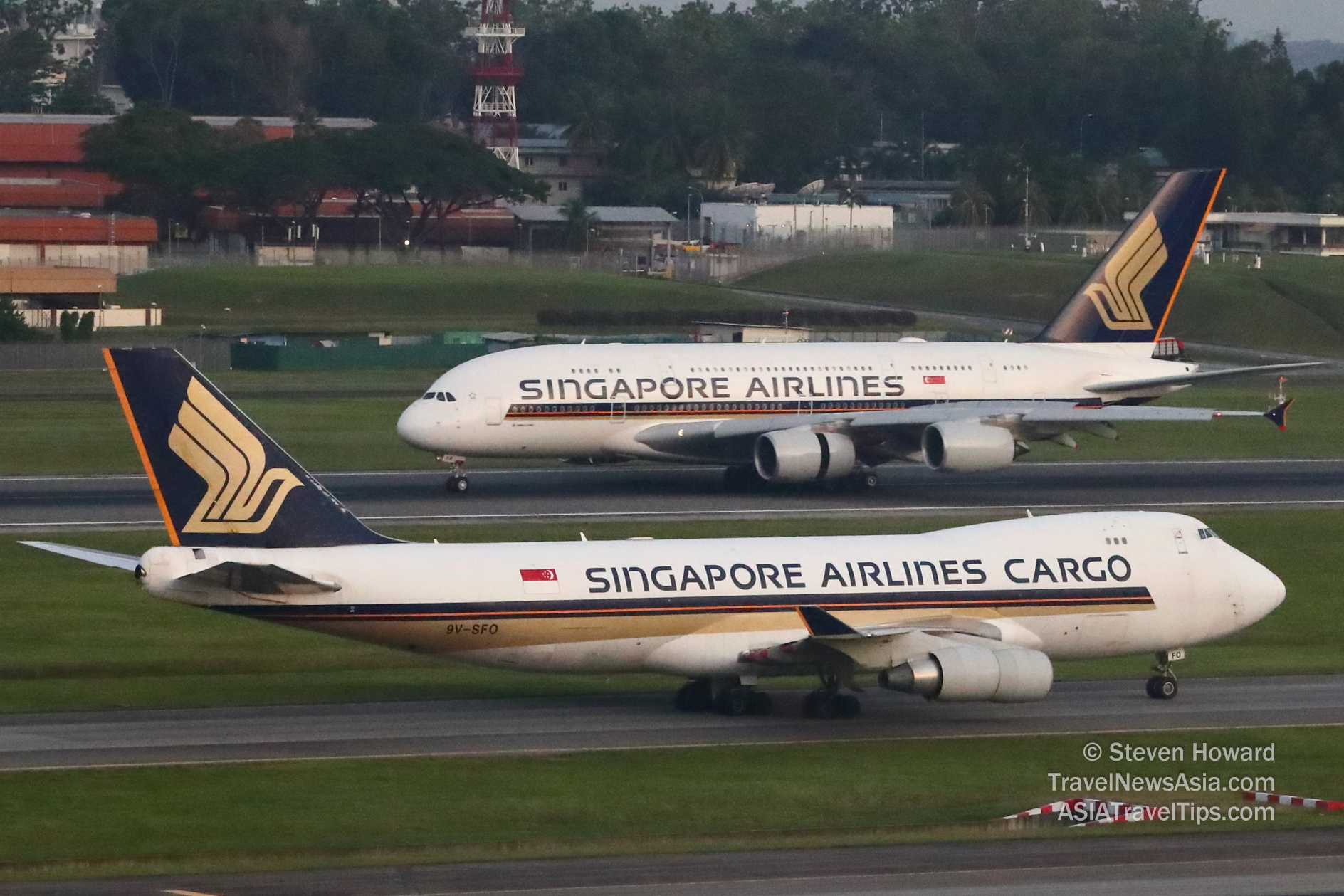|
(12 Nov 2021)
In H1 FY2021/22, Singapore Airlines (SIA) Group's passenger traffic, measured in revenue passenger-kilometres
(RPKs), grew five-fold year-on-year, with passenger capacity (ASKs) also growing five-fold year-on-year to reach
32% of pre-COVID19 levels as of September 2021.
Group
revenue rose $1,193 million (+73%) year-on-year to $2,827
million, attributable to improvements in both the passenger and
cargo segments.
Passenger flown revenue grew by $598 million
(+385.8%) on the back of the recovery in traffic, partly
offset by weaker yields.
Cargo flown revenue reached a record high
of $1,875 million (+$635 million or +51.2%) with the
progressive resumption of passenger flights contributing to
the increase in cargo capacity (+49.5%) and loads carried
(+61.6%).

Singapore Airlines passenger and cargo aircraft. Picture by Steven Howard of TravelNewsAsia.com
The strong cargo performance reflects the capacity
crunch in both air freight and ocean freight, and ongoing
supply chain disruptions driving air freight demand.
Group
expenditure fell $51 million (-1.5%) to $3,446 million. This was
mainly due to the absence of the fuel hedging ineffectiveness
that was recorded last year, and the swing from fair value loss
to gain on fuel derivatives arising from the rise in fuel
prices during the first half of the year.
This was mostly offset
by net fuel costs which rose $434 million (+115.4%) to $810
million, mainly due to higher fuel prices and an increase in volume uplifted to support the expansion in passenger operations.
Non-fuel expenditure also rose by $157 million (+6.1%) to
$2,715 million, as higher costs were incurred from increased
flying activities.
As a result, the SIA Group recorded an
operating loss of $619 million for the first half, an
improvement of $1,244 million (+66.8%) from the $1,863 million
operating loss in the previous year.
For the half year ended
30 September 2021, the group reported a net loss of $837
million, an improvement of $2,630 million (+75.9%) from the prior year. This was mainly due to better operating performance, and
the absence of $1,630 million in non-cash items recorded last
year largely from the impairment of aircraft assessed to be
surplus to requirements.
The operating cash deficit for the
first half narrowed to $106 million (or an average of $18
million per month) from $1,726 million last year, on the back of
better operating performance.
Group revenue rose $237
million (+18.3%) quarter-on-quarter to $1,532 million.
Passenger flown revenue increased by $118 million (+37.2%) as passenger traffic grew 43.4% quarter-on-quarter, outpacing the
21.5% expansion in capacity. As a result, passenger load
factor (PLF) improved 2.6 percentage points compared to the
previous quarter to 17.4%.
The launch of Singapore�s first
quarantine-free VTL arrangements with Brunei and Germany on 8
September 2021 resulted in an uptick in demand, especially to
Germany.
Cargo flown revenue increased by $122 million (+13.9%), as yields remained elevated (+5.2%) and loads carried improved
(+8.5%) as supply chain disruptions intensified, exacerbating
the industry�s capacity crunch.
Group expenditure grew $308
million (+19.6%) as the expansion in passenger operations led
to higher net fuel costs of $450 million, up $90 million (+25.0%) against the previous quarter, driven by higher fuel volume
uplifted (+$67 million), higher fuel prices (+$41 million),
strengthening of USD against SGD (+$8 million), partially offset by higher hedging gains (-$26 million). There was also a lower
fair value gain on fuel derivatives of $65 million
quarter-on-quarter. Non-fuel expenditure increased $153
million (+11.9%), in line with the expanded operations.
Consequently, the group recorded an operating loss of $345
million, higher by $71 million (+25.9%) as compared to the
previous quarter. Net loss for the second quarter of FY2021-22
came in at $428 million, a slight increase of $19 million (+4.6%)
quarter-on-quarter.
First Half FY2021/22 � Balance Sheet
As
at 30 September 2021, the group shareholders� equity was $22
billion, an increase of $6.1 billion compared to 31 March
2021. Cash and bank balances saw an increase of $4.7 billion,
rising to $12.5 billion primarily due to the issuance of the
Rights 2021 Mandatory Convertible Bonds. Total debt balances
increased by $0.7 billion to $15.1 billion, attributable to
the increase in lease liabilities as a result of sale-and
leaseback activities.
Consequently, the group�s debt-equity ratio
fell from 0.90 times to 0.69 times. In addition to the cash on
hand, the group continues to retain access to $2.1 billion of
committed lines of credit, all of which remain undrawn at present.
Fleet
and Network
During the second quarter, six Boeing 737-8
MAX aircraft were transferred from SilkAir into the SIA
operating fleet as part of the integration of SilkAir into SIA.
This followed the removal of the Civil Aviation Authority of
Singapore�s restrictions on the operation of these aircraft.
In addition, one A350 aircraft delivered in the first quarter
entered the operating fleet in the second quarter.
The last Airbus
A330 aircraft was removed from the operating fleet for lease
return checks.
At the end of September 2021, SIA�s operating
fleet comprised 121 passenger aircraft and seven freighters. The 121 passenger aircraft comprised: 23 777-300ERs, 12
A380s, 56 A350s, 15 787-10s, 9 737-800s and 6 737-8 MAXs.
Scoot added one more A321neo aircraft into its operating fleet
bringing its fleet size to 50 passenger aircraft. The 50 passenger aircraft comprised: 10 787-8s, 10
787-9s, 21 A320ceos, 5 A320neos and 4 A321neos.
As at
30 September 2021, the group had an operating fleet of 171
passenger aircraft and seven freighters. At an average age of six
years, this is one of the youngest airline fleets in the
industry.
During the quarter, SIA resumed passenger services
to Cape Town, Kathmandu, Manchester, and Rome. Scoot
re-introduced flights to Berlin (via Athens) and Sydney.
Medan, Nanjing and Surabaya services were temporarily suspended
due to airport closures.
At the end of September 2021, SIA
served 525 destinations while Scoot covered 245 points. The
group�s passenger network covered 655 destinations, up from 63
compared to the previous quarter. The group�s cargo network
comprised 785 destinations, up from 76 as at the end of the
prior quarter.
Singapore took a major step in re-opening its
borders and restoring its status as an international air hub
on 8 September, when the first VTL services were launched from
Brunei and Germany.
The VTL arrangements have since been expanded to include Australia, Canada, Denmark, Finland, France, Italy,
Malaysia, the Netherlands, South Korea, Spain, Sweden,
Switzerland, the United Kingdom, and United States of
America.
At present, the SIA Group�s VTL network consists of 21
cities from 14 countries, though this is expected to expand in the
near future.
SIA will resume Airbus A380
operations to London from 18 November 2021 and Sydney from 1
December 2021 to support the increased demand on these routes.
SIA will re-instate flights to Houston (via Manchester) on 1
December 2021, and launch a seasonal
Singapore-Seattle-Vancouver service from 2 December 2021.
Scoot
started non-stop services to Berlin on 19 October 2021, and
will commence flights to Incheon from 15 November 2021 and Davao from 1 December 2021.
Based on current published
schedules, the group expects passenger capacity to reach 43%
of pre-COVID levels by December 2021. The Group network will
serve just over half of the total pre-COVID points, or 73
destinations including Singapore.
Fuel Hedging
Following the outbreak of the COVID19 pandemic, there was a
significant reduction in the group�s capacity and hence fuel
consumption, compared to prior planned flight schedules.
In
view of the reduced consumption and the uncertainty that
remains in the recovery profile, the group took steps in the first
half of FY2021/22 to recalibrate its fuel hedge book closer to
a neutral posture through sell swaps to close out some of the
prior hedge positions.
The group is currently hedged in Brent
at about 30% of expected consumption for the second half of
FY2021/22, at an average price of US$57 per barrel.
For the
period between the first quarter of FY2022/23 and the first
quarter of FY2023/24, the group has hedged about 40% of
expected consumption at an average price of US$60 per barrel.
Hedge positions beyond the first quarter of FY2023/24 have been
closed out.
The close-out trades, taken in a period of rising
oil prices, have locked in gains of US$352 million, of which
US$120 million has already been recognised under fair value
gains in prior periods.
The remaining Profit and Loss impact from
these close-out trades would amount to US$24 million for the
second half of FY2021/22 and US$208 million for the periods
beyond.
Interim Dividend
In view of the significant losses
incurred and the need to conserve cash, the SIA's Board is not
proposing an interim dividend for the half-year ended 30 September
2021.
Outlook
Beyond Singapore, key Asia-Pacific
markets continue to gradually open up. Australia removed
restrictions on outbound travel for its residents on 1 November,
and will reopen its borders to all vaccinated Singaporeans from
21 November. With Singapore�s earlier inclusion of Australia
in its VTL arrangements, this establishes two way quarantine-free
travel between Singapore and the Australian states of New South Wales and Victoria.
Within South East Asia, Singapore has
announced a bilateral VTL agreement with Malaysia, and
adjusted the risk classification for some countries, including
Indonesia, Vietnam and Thailand. This gives Singapore scope to
start opening up its borders with countries in the region.
The traditional year-end cargo peak period is
expected to see strong demand, supported in part by retail
inventory restocking before the peak shopping season. This
comes amid an ongoing industry capacity crunch for both air
freight and ocean freight.
Purchasing Managers� Indices are still in expansionary territory for key export economies,
boding well for air cargo demand. Nonetheless, some economies are
now facing production constraints as a result of pandemic
controls, supply chain disruptions, and energy shortages.
Expansion of bellyhold capacity will continue with
the resumption of passenger flights, and the continued deployment of passenger aircraft for cargo-only flights as
required.
Fuel prices have been trending higher on the back of
a resurgence in demand, and volatility is expected to persist
in the near term, amid a global energy crunch.
|
Headlines: |
|
|
